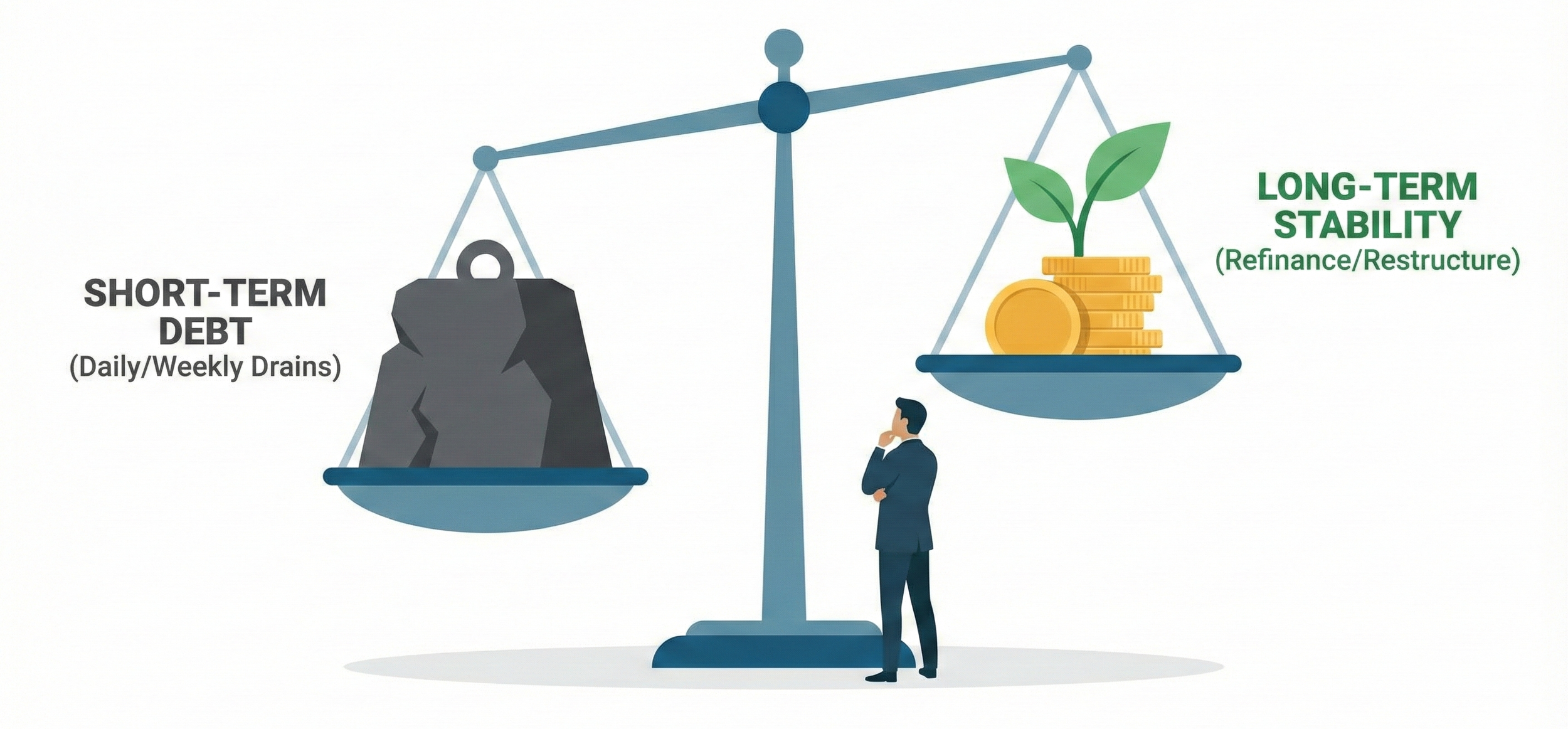A Business Turnaround Plan is not a suggestion; it's a brutal, immediate action to halt the bleeding, stabilize the cash position, and force profitability back into the ledger.
This process is a high-stakes financial war fought on three fronts: aggressive cash flow correction, ruthless balance sheet restructuring, and a total overhaul of the profit and loss statement.
You must abandon sentimentality, embrace radical change, and execute with an almost militaristic discipline to extract the business from its current downward spiral and forge a sustainable, profitable entity.
The Unflinching Diagnosis: Confronting Financial Collapse
The first step in any genuine turnaround is abandoning the delusion of "temporary trouble."
Your financial statements are not just signaling weakness—they are screaming insolvency if left unchecked. You must immediately conduct a forensic-level financial audit. Forget the glossy summaries and drill down into the granular data.
Your Profit and Loss (P&L) statement must be dissected to identify the exact point of value destruction.
Which product lines or customer segments are draining resources and masking losses?
Pinpoint the fixed and variable costs that have inflated beyond reasonable levels. Simultaneously, your Balance Sheet must be treated as a liability map. Aggressively write down or sell all non-performing assets, liquidate obsolete inventory that is tying up capital, and scrutinize accounts receivable for uncollectible debt.
This diagnostic phase is about establishing the True Financial Picture—the ugly truth that will inform the necessary, painful cuts and capital injections to come. Without this ruthless clarity, any subsequent action is simply a gamble.
Cash Is King, and Yours Is Dying: Immediate Cash Flow Stabilization
Cash is the oxygen, and your business is suffocating.
The immediate priority is cash flow triage—stopping the burn and extending your runway. This means an immediate, non-negotiable crackdown on Accounts Receivable (AR). Stop granting generous credit terms and adopt an aggressive collection policy. Offer steep discounts for immediate payment and be prepared to use every legal means necessary to reclaim overdue funds.
Simultaneously, you must exert maximum pressure on Accounts Payable (AP). Engage your key suppliers immediately. Do not apologize; present your credible turnaround plan and negotiate extended payment terms, demonstrating that it is in their financial interest to keep you viable.
Implement an across-the-board Capital Expenditure (CapEx) freeze and immediately divest any underperforming or non-essential assets to generate quick cash. Every day that passes without a positive shift in your cash position is a day closer to failure.
The Profit and Loss StatemeNT Overhaul: Extracting Profit from Pain
Your existing P&L structure is a roadmap to failure; it must be completely dismantled and rebuilt.
The focus shifts from top-line revenue to gross profit margin and operational leverage.
Begin with Cost of Goods Sold (COGS). Aggressively renegotiate vendor contracts, demand deeper volume discounts, and simplify product specifications to reduce input costs. If a product line does not generate a predetermined, acceptable gross margin, it is immediately cut or outsourced.
Next, attack Operating Expenses (OpEx) with a hatchet, not a scalpel. Challenge every single line item. This means non-essential salaries, excessive marketing spend, redundant technology licenses—all must go. Implement zero-based budgeting where every expense must be justified from a base of zero.
This is where the emotional resilience is tested: you must make the personnel cuts and operational closures that align with the core, profitable segments, ignoring all legacy attachments.
Balance Sheet Warfare: De-Leveraging and Asset Discipline
A weak balance sheet is a ticking bomb. The turnaround demands aggressive de-leveraging and asset optimization. Review every debt obligation. Negotiate with lenders for interest-only periods, covenant waivers, or a restructuring of principal payments based on your new, credible financial projections.
You must demonstrate that the business, post-restructuring, has a clear path to debt service coverage. On the asset side, inventory must be managed with extreme prejudice. Liquidate slow-moving or obsolete stock at cost if necessary—the cash locked in those goods is more valuable than the theoretical margin. Ensure your working capital cycle is minimized; if it takes too long to convert raw materials into cash, your operational model is broken and needs immediate redesign.
A strong balance sheet means maximizing liquidity and minimizing risk, freeing up collateral and credit capacity for the inevitable next stage of investment.
Refocus and Reposition: The Core Competency Mandate
Businesses often fail because they lose focus chasing fleeting opportunities that dilute resources. Your turnaround demands a singular, ruthless strategic focus.
Analyze your P&L data to identify the one or two core products or services that generate the highest sustainable margins. Everything else is a distraction. Immediately divest, outsource, or discontinue the non-core activities, regardless of historical volume or pride of ownership.
This aggressive segmentation allows you to concentrate all remaining financial resources—labor, marketing spend, and CapEx—on the areas where your business can dominate and dictate price. Your new value proposition must be narrow, specific, and backed by a cost structure that is superior to your competition in that specific niche.
Funding the Fight: Securing Credible Capital
To survive, you will likely need an immediate cash infusion to bridge the stability gap.
Securing capital in a turnaround is an exercise in selling a vision of recovery, not begging for a bailout.
You must present lenders and potential equity investors with the stress-tested financial model derived from your P&L and Balance Sheet overhaul. Show them the cuts made, the efficiencies gained, and the clear path to positive EBITDA and debt service capacity.
Explore all structured finance options: asset-backed lending (ABL) against your remaining quality receivables and inventory, or even factoring to unlock immediate cash at a cost. If external financing is unattainable, you must demand a capital contribution from the owners or liquidate more assets. Every negotiation requires absolute transparency and a willingness to accept stringent reporting covenants.
The goal is to secure enough capital to execute the operational plan, not to merely fund prior losses.
The Leadership Hammer: Talent Alignment and Accountability
A turnaround demands a leadership shift from consensus-building to decisive, centralized authority. Your management team must either commit fully to the brutal execution of the plan or be replaced immediately. There is no room for passive resistance or mediocrity. Identify and retain only the A-players who are intellectually and emotionally aligned with the new, leaner, aggressive structure.
Every remaining employee must be indoctrinated into the new culture of financial discipline. Implement a rigorous accountability structure tied directly to the turnaround KPIs—cash flow targets, margin adherence, and cost reduction milestones. Compensation and bonuses must be entirely based on achieving these financial targets. The people who remain must be focused, hardworking, and energized by the fight for survival; anything less is a liability you cannot afford.
Execution: The Turnaround Dashboard and Weekly Rhythm
A plan is worthless without fanatical execution. You must establish a Turnaround Dashboard consisting of no more than eight leading financial and operational indicators that you review daily or weekly, not monthly. Key metrics must include Daily Cash Position, AR Collections Rate, Gross Margin by Core Product, and OpEx Variance to Budget.
Implement a mandatory weekly operational review meeting—short, intense, and focused solely on variances from the plan. No excuses are tolerated; every deviation requires an immediate corrective action assigned to a single, accountable individual. This aggressive, high-frequency monitoring system ensures that errors are caught and corrected within days, not weeks or months. This is where the execution is proven—the discipline to stick to the plan even when it becomes uncomfortable.
Sustainable Dominance: Embedding Financial Discipline
The ultimate victory is not survival; it is the creation of a fundamentally more robust, financially disciplined, and profitable enterprise. Once the immediate crisis passes, the aggressive practices—the tight cash control, the rigorous P&L adherence, the minimal working capital—must become the permanent culture.
Institutionalize the weekly dashboard review and maintain the high standard of accountability. The capital freed up by the turnaround must be reinvested strategically back into the core, high-margin areas that secured the business's survival. Your past failure was a costly lesson; the permanent embedding of this financial and operational discipline is the only path to long-term market dominance. Your new business model must be inherently resilient to market pressures.
What is the Best Way to Deal with Business Debt Payments that are causing Business Cash Flow issues?
It is NOT by stopping ACH payments.
It is NOT by taking on another business loan.
It is NOT ALWAYS a Refinancing
It is NOT by entering into a debt settlement program.
Find out the BEST strategies to get your Business back to where it was






























